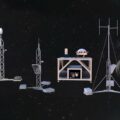Most mainstream scientists argue that the possible existence of spacecraft from a non-human origin is an “extraordinary claim” that is not worth a serious study until “extraordinary evidence” falls to their lap.
The reason this evidence has to fall into their lap is because they are not engaged in the search for such evidence, and so its non-existence is a self-fulfilling prophecy. The simple answer to Enrico Fermi’s paradox: “Where is everybody?” is “To find out whether you have neighbors, you better use a telescopes or check your backyard for objects that came from the street.”
Over the past two years, the Galileo Project that I lead at Harvard University, engaged in these activities – as summarized in 8 peer-reviewed papers. But we must keep also in mind that the intelligence and defense agencies of the US Government are tasked with identifying objects falling from the sky for decades, since some of these objects may represent drones, spy balloons or ballistic missiles sent by adversarial nations. Given this “day job,” it is clear that Government agencies are likely to be (or have already been) the first to notice extraordinary evidence for Unidentified Anomalous Phenomena (UAP) associated with any objects sent by extraterrestrial technological civilizations to our cosmic backyard.
When I sat next to the Director of National Intelligence, Avril Haines, at the Ignatius Forum at the Washington National Cathedral in November 2021, I asked her: “Given your bachelor’s degree in physics from the University of Chicago, what is your guess for the nature of the most anomalous UAP in your 2021 report to Congress?” She admitted, “I do not know.”
However, during our public discussion on stage, Avril noted, “There’s always the question of ‘is there something else that we simply do not understand, that might come extraterrestrially?’” This was ten months after my book Extraterrestrial was published, in which I discussed the possible technological explanation for the multiple anomalies including the disk-likeshape and non-gravitational acceleration exhibited by the interstellar object, `Oumuamua, observed by standard astronomical telescopes.
But the first recognized interstellar object actually impacted Earth in January 2014. The forthcoming expedition of the Galileo Project to the Pacific Ocean aims to discover whether this interstellar meteor, IM1, was a craft from an extraterrestrial civilization. The reason for considering an artificial origin of this half-meter-sized object is that it was tougher in material strength than all other 272 meteors in the CNEOS catalog of NASA, and was formally recognized as having an interstellar origin at the 99.999% confidence in an official letter from the US Space Command to NASA on March 1, 2022.
Today, a report by whistleblower David Grusch was published by The Debrief, written by the highly reputable journalists Leslie Kean and Ralph Blumenthal. Grusch served as a representative to the UAP Task Force and co-lead for UAP analysis.Grusch says recoveries of extraterrestrial objects of non-human origin have been ongoing for decades by the US Government, allies, and defense contractors.
Jonathan Grey, an intelligence officer specializing in UAP analysis at the National Air and Space Intelligence Center, said that “a vast array of our most sophisticated sensors, including space-based platforms, have been utilized by different agencies, typically in triplicate, to observe and accurately identify the out-of-this-world nature, performance, and design of these anomalous machines, which are then determined not to be of earthly origin.”
Though a tough nut to crack, potential technological advancements may be gleaned from non-human intelligence/UAP retrievals by any sufficiently advanced nation and then used to wage asymmetrical warfare, so, therefore, some secrecy must remain,” he added. “However, it is no longer necessary to continue to deny that these advanced technologies derived from non-human intelligence exist at all or to deny that these technologies have landed, crashed, or fallen into the hands of human beings,” he said.
Nevertheless, as a scientist who is guided by evidence I must bring up a cautionary remark: there are no scientific details in this report. I can only assess the significance of open data or materials to which I have direct access.
While the government is responsible for national security matters, the possible existence of extraterrestrial technological civilizations entails scientific knowledge about the Universe that does not adhere to national borders and should be shared with all humans.
As much as eyewitness testimonies on the existence of classified evidence are intriguing, we can make progress in our scientific knowledge only by having direct access to the primary sources of materials or data without relying on hearsay. Eyewitness testimonies have implications in the court of law but are not sufficient for corroborating scientific statements.
Therefore, as much as Grusch’s report is intriguing, it does not carry credible scientific evidence irrespective of the comments about Grusch’s reliability. What we wish to see as scientists is the actual materials or data collected by the government. Without access to the evidence, we cannot distinguish Grusch’s report from a hypothetical story which was frabricated by a secret branch of government that is developing unusual technological capabilities while assigning them to an extraterrestrial origin.
Evidence that is publicly available to all scientists worldwide is the only way by which scientific progress about our place in the cosmos can be made. Here’s hoping that the findings of the Galileo Project’s expedition will inspire the US government to release open data about its own findings. We already know that the first two objects spotted by scientists as originating from outside the solar system, did not resemble the familiar meteors, asteroids or comets in the solar system, and were explained by mainstream astronomers as objects of a type that we had never observed before.
The fundamental question here is whether the recovery of non-human crafts will be good for the future of humanity?
My answer is a resounding yes, as explained in my forthcoming book, Interstellar. First, this new understanding would allow us to recognize scientific and technological knowledge that goes beyond what we acquired over the past century. Our current scientific knowledge has giant holes. To name a few of them: What is the nature of dark matter and dark energy that make 95% of the mass budget in the present-day Universe? What happened before the Big Bang? What happens to matter or radiation that fall into a black hole? How are quantum mechanics and gravity unified? When did life start to form in the Universe? How many technological civilizations preceded us in our own Milky-Way galaxy alone and what did they accomplish? What are the capabilities of the most advanced form of artificial intelligence (AI)? Is time travel possible?
Whenever new knowledge is acquired, it leads to new questions, and so it is likely that we will learn things in the new era that we cannot even imagine – given our limited knowledge in the past era.
Second, the transition to will be accompanied by a new perspective on our place in the Universe, akin to the realization of my daughters that there are smarter kids in their neighborhood after their first day in kindergarten. This realization will change our aspirations for space in an attempt to imitate the inspiring capabilities of our neighbors.
Third, realizing that there are superhuman capabilities beyond the solar system would bring a sense of awe and admiration that characterized traditional religions and belief in God. Just imagine the deep feelings that a family of cave dwellers would experience during a visit to the present-day New York City.
Fourth, a global perspective that extends beyond Earth may convince humans that conquering a piece of land on the rock that we happened to inhabit or feeling superior relative to other people based on their ethnic origins or skin color are ridiculously superficial and inappropriate in the grander scheme of reality.
My sincere hope is that it will convince us to respect each other as equal members of the human species. Instead of spending 2 trillion dollars each year on military budgets, we could invest the financial surplus in space exploration and send a CubeSat with AI towards every star in the Milky-Way galaxy by the end of the century. As Oscar Wilde noted, “Imitation is the sincerest form of flattery.”
In this context, the flattery is extended towards our interstellar neighbors.
Avi Loeb is the head of the Galileo Project, founding director of Harvard University’s – Black Hole Initiative, director of the Institute for Theory and Computation at the Harvard-Smithsonian Center for Astrophysics, and the former chair of the astronomy department at Harvard University (2011-2020). He chairs the advisory board for the Breakthrough Starshot project, and is a former member of the President’s Council of Advisors onScience and Technology and a former chair of the Board on Physics and Astronomy of the National Academies. He is the bestselling author of “Extraterrestrial: The First Sign of Intelligent Life Beyond Earth” and a co-author of the textbook “Life in the Cosmos”, both published in 2021. His new book, titled “Interstellar”, is scheduled for publication in August 2023.

